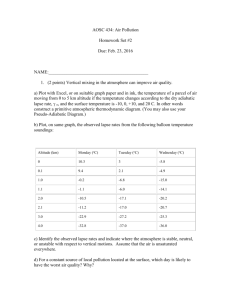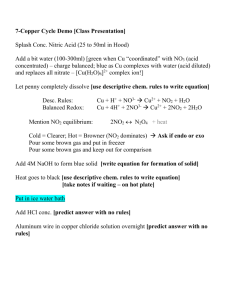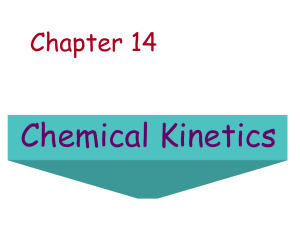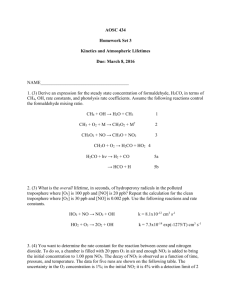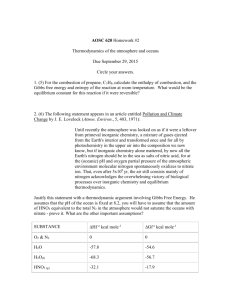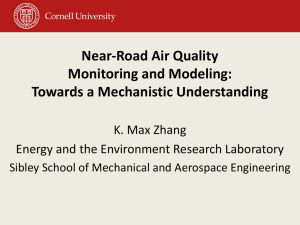Lesson: Reaction Mechanisms
advertisement
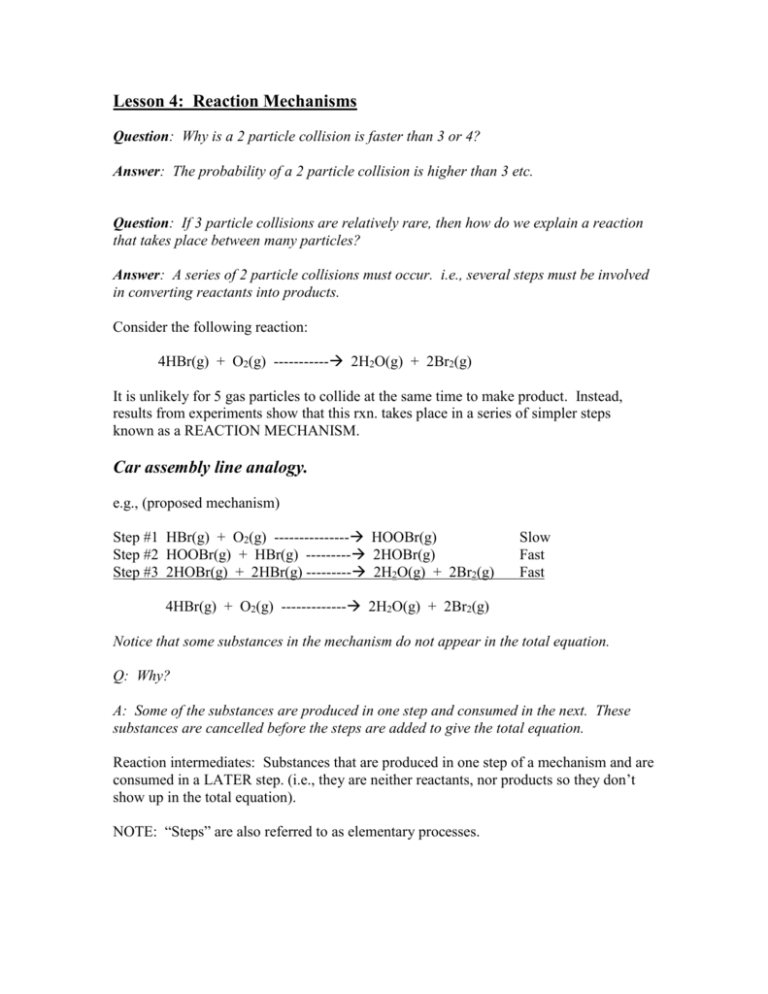
Lesson 4: Reaction Mechanisms Question: Why is a 2 particle collision is faster than 3 or 4? Answer: The probability of a 2 particle collision is higher than 3 etc. Question: If 3 particle collisions are relatively rare, then how do we explain a reaction that takes place between many particles? Answer: A series of 2 particle collisions must occur. i.e., several steps must be involved in converting reactants into products. Consider the following reaction: 4HBr(g) + O2(g) ----------- 2H2O(g) + 2Br2(g) It is unlikely for 5 gas particles to collide at the same time to make product. Instead, results from experiments show that this rxn. takes place in a series of simpler steps known as a REACTION MECHANISM. Car assembly line analogy. e.g., (proposed mechanism) Step #1 HBr(g) + O2(g) --------------- HOOBr(g) Step #2 HOOBr(g) + HBr(g) --------- 2HOBr(g) Step #3 2HOBr(g) + 2HBr(g) --------- 2H2O(g) + 2Br2(g) Slow Fast Fast 4HBr(g) + O2(g) ------------- 2H2O(g) + 2Br2(g) Notice that some substances in the mechanism do not appear in the total equation. Q: Why? A: Some of the substances are produced in one step and consumed in the next. These substances are cancelled before the steps are added to give the total equation. Reaction intermediates: Substances that are produced in one step of a mechanism and are consumed in a LATER step. (i.e., they are neither reactants, nor products so they don’t show up in the total equation). NOTE: “Steps” are also referred to as elementary processes. The slowest step in a mechanism is called the rate determining step. Q: Why? A: B/c the slowest step determines the overall rate of the rxn (i.e., the highest Ea). e.g., Car assembly line, and “superman principle”. Q: How do we significantly increase the rate of a reaction with more than one step? A: Speed up the rate determining step by: 1. adding a catalyst to lower the Ea of the r.d.s. 2. increase concentration of reactants in the r.d.s 3. inc. temp. Speeding up a step which is already fast does not significantly increase the rate of the overall rxn. Problems: 1. a. b. c. d. Find the net equation for the two step mechanism below. Identify any reaction intermediates. Identify any catalysts. Identify the activated complexes in Step1 and step 2. Step #1: Step #2: Total: NO2(g) + SO2(g) --------- SO3(g) + NO(g) NO(g) + 1/2O2(g) --------- NO2(g) Solution: Step #1: Step #2: Total: NO2(g) + SO2(g) --------- SO3(g) + NO(g) NO (g) + 1/2O2(g) --------- NO2 (g) SO2(g) + 1/2O2(g) ------- SO3(g) NO is a rxn intermediate NO2 is a catalyst NSO4, NO2 2. a. b. c. d. Step #1: Step #2: Total: Fill in the missing species. Identify any reaction intermediates. Identify any catalysts. Identify the activated complexes in Step1 and step 2. H+ + H2O2 ---------- H3O2+ H3O2+ + _?__-------- H2O + HOI H+ + I- + H2O2 ----- H2O + HOI Solution: I-, H3O2+, none, H3O2+ and H3O2I 3. The following reaction occurs in a 3 step reaction mechanism: 2Ce+4 + Tl+ --------- 2Ce+3 + Tl+3 Determine the third step given: Step #1: Step #2: Step #3: Ce+4 + Mn+2 ----------- Mn+3 + Ce+3 Ce+4 + Mn+3 ----------- Mn+4 + Ce+3 _____________-----------______________ Solution: ** Add the reverse of each step from the overall reaction** Step #1: Step #2: Step #3: Total: Ce+4 + Mn+2 ----------- Mn+3 + Ce+3 Ce+4 + Mn+3 ----------- Mn+4 + Ce+3 Tl+ + Mn+4 ----------- Mn+2 + Tl+3 2Ce+4 + Tl+ --------- 2Ce+3 + Tl+3

